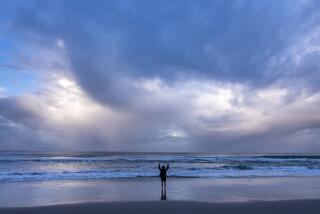Good news for California water supply: Spring snowpack still deep and will melt slowly
Four months ago, surveyors with the California Department of Water Resources probed the frozen ground in a field in the Sierra Nevada, calculating the first snowpack of the year, an important measurement of the state’s water supply.
On Thursday, they returned for the season’s final tally — one not typically recorded in May because there often isn’t any snow left that late in the year — and were pleased with the results.
Although the measurement was a big decline from the previous month, and one that was expected, it was still better than usual for this time of year: 188% of average for the day.
The DWR’s monthly snowpack surveys typically attract hordes of reporters and photographers, but the latest one occurred without the usual entourage. The measurement has taken place for decades outside a cabin known as Phillips Station that sits at 6,820 feet elevation near Echo Summit. But the wooden structure was destroyed in a fire last month, so the state agency opted not to invite the media to the site out of respect for the cabin’s owner, said Chris Orrock, spokesman for the Department of Water Resources.
Instead, a team of water experts and surveyors hiked to their usual spot and made their marks alone. The snowpack measured 47 inches, with 27.5 inches of snow-water content, Orrock said.
This season’s snowfall has been frequent and steady, which experts think will help sustain the state’s reservoirs for longer than usual. The April 1 measurement, which is typically the largest and is used by the state to make decisions about water supplies, measured 106.5 inches and 51 inches of snow-water content.
That snowpack measurement was slightly smaller than the month before because there was a brief period of warmer weather that melted some snow, but the snow-water content measurement was still the fourth-best on record.
The snowpack is tested in May only when there’s enough snow to measure. The last time that happened was in 2017, and in 2011 before that, Orrock said.
A series of atmospheric river storms during the winter made for above-average snow levels that doubled several times, full reservoirs and streams, and even left California drought-free for the first time in nearly a decade.
While 2017 was a banner year for precipitation in California, most of the rain that fell on the state was the result of warm atmospheric rivers, which created conditions that caused the snowpack to melt quickly during the spring season.
The atmospheric river storms the state experienced this year were often coupled with a cold front, which lowered temperatures and likely will keep the snowpack intact longer, Orrock said.
“It’s a very dense and cold snowpack,” he said. “An icy crust on the surface of it helps maintain the snowpack.”
He added that experts expect the snow to melt slowly, replenishing reservoirs all the way through August.
On Thursday, surveyors closed out a great snow year amid a tragic backdrop. About 100 feet up the mountain stood the charred remains of a burned-out cabin owned by Carol Pearson, who also owns the property where the snow survey takes place annually. The wooden home was gutted April 12, but the charred debris still haunted the area, which was still surrounded by snow, Orrock said.
Pearson, 67, has opened her property to the Department of Water Resources for years, and it has been the site of the Phillips snowpack measurement since 1941, the Sacramento Bee reported.
The woman and her daughter, who both lived in the cabin, set up a GoFundMe page to raise money to rebuild their home. On Thursday, 12 people had raised $2,800 toward a $90,000 goal.
“Those that had the opportunity to visit our home said it was like walking into a museum; it was filled with unique artifacts connecting our local and family history,” the Pearsons said in the fundraising page. “We have lost it all and are devastated to say the least! We are at a complete and total loss and have nothing left but our land.”
The family sifted the debris the day before the snow survey, and Pearson was able to find her mother’s wedding band, Orrock said.
“She said this is her mountain,” he said. “She plans on rebuilding as soon as she can.”
Despite the cabin’s loss, the state department will continue using the Phillips Station for its annual snow surveys — with Pearson’s permission, Orrock said.
Twitter: @r_valejandra
More to Read
Sign up for Essential California
The most important California stories and recommendations in your inbox every morning.
You may occasionally receive promotional content from the Los Angeles Times.












